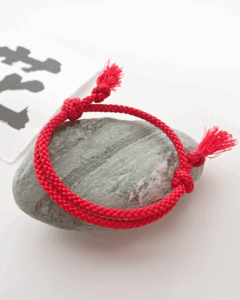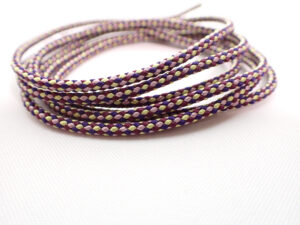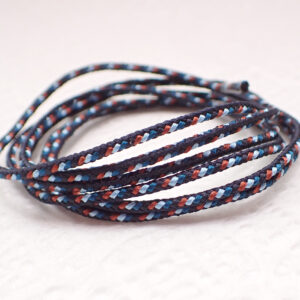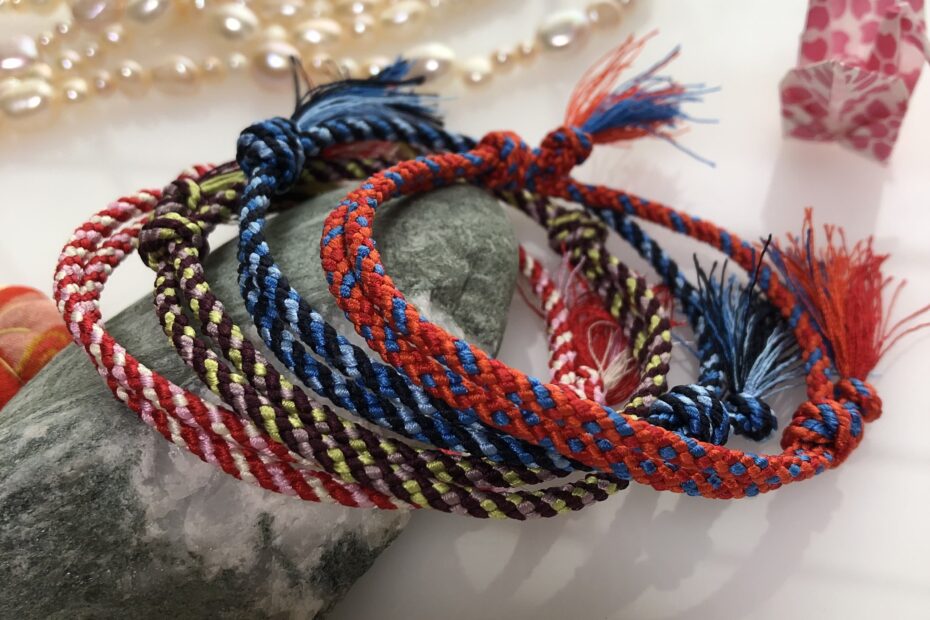In Japanese animation, a single thread can carry the weight of a lifetime. It binds lovers across time, holds memories that refuse to fade, and connects the human heart to something beyond sight. The art of kumihimo—traditional Japanese braided cords—embodies this idea of musubi, the act of tying together.
From Your Name’s red cord of destiny to the quiet bonds in My Happy Marriage, the luminous threads in The Heike Story, and the hair tie that glows with gratitude in Spirited Away—each reveals how modern anime continues Japan’s ancient language of connection. This article explores how these delicate strands of silk and color weave emotion, spirituality, and culture into unforgettable storytelling.
1. Your Name (君の名は。) — The Red Cord Across Time
The vivid red braided cord in Your Name is more than a simple hair accessory—it is the film’s beating heart. Worn by Mitsuha and later passed to Taki, it transcends time and memory, linking two souls who have never met yet can never forget. Its twists and turns mirror the nonlinear flow of the story itself—interwoven, separated, and ultimately reconnected.
In Japanese folklore, the red thread of fate (akai ito) binds those destined to meet. Director Makoto Shinkai transforms this myth into a tangible craft: the kumihimo becomes a handmade bridge between the divine and the human, the visible and the unseen.

Atelier Miyabi — Red “Thread of Fate” braid.
A handcrafted silk kumihimo reflecting the timeless bond between hearts. Its crimson and gold tones embody celebration, destiny, and devotion—the same spirit carried by Mitsuha’s ribbon.
2. My Happy Marriage (わたしの幸せな結婚) — The Quiet Art of Binding Hearts
In contrast to the cosmic scale of Your Name, My Happy Marriage speaks of bonds on a gentler, human scale. Here, the act of tying a ribbon or fastening a sash becomes a metaphor for trust—the courage to open one’s heart after pain. When Kiyoka gifts Miyo a hair ornament, its braided threads quietly affirm: “You are safe to be seen.”
In Shinto culture, to tie (musubu) also means to purify and unite energies. This symbolism runs deep within the film’s design—soft colors, flowing silk, and the calm rhythm of connection born from sincerity.

Atelier Miyabi —“Shion no Utage – Banquet of Violets” from Kyo no Irodori
A braid of quiet grace — where sorrow turns to strength, and gentleness becomes light.
Inspired by My Happy Marriage, this kumihimo reflects the beauty of trust reborn.
3. The Heike Story (平家物語) — Threads of Life and Impermanence
Yamada Naoko’s adaptation of the Heike Monogatari opens with threads drifting through water and light—an ethereal representation of life’s transience. Each shimmering filament seems to hold the voices of the departed, their stories still intertwined with the living.
This visual language echoes the Buddhist idea of engi—interdependent origination. No life exists in isolation; all are connected like threads in a braid. To weave, to unravel, to weave again—this is the rhythm of existence itself.
Scene from “The Heike Story” (2021) © Science SARU / Fuji TV.
Used for analysis and educational commentary under fair use.
Atelier Miyabi — “Elegant Gold” braid.
A kumihimo of gold and violet, symbolizing impermanence and remembrance. Each crossing thread honors the idea that beauty exists because it will one day fade.
4. Spirited Away (千と千尋の神隠し) — The Invisible Thread of Memory
When Chihiro receives a small braided hair tie from Zeniba, she doesn’t realize it carries the love and effort of her friends. Later, when it glows during her final test, that light becomes the essence of musubi—connection born from gratitude.
Studio Ghibli often portrays labor as prayer, and craft as a bridge between worlds. The hair tie—simple, handmade, sincere—embodies the Japanese belief that care invested in creation imbues it with spirit.

Atelier Miyabi — “Yoiboshi – Evening Star” from Kyo no Irodori
A thread of quiet light, born between night and dawn.
Like Chihiro’s glowing hair tie in Spirited Away, it carries gratitude and courage through the dark.
The Cultural Continuity of Kumihimo — From Ancient Craft to Anime Aesthetics
Long before kumihimo appeared in animation, it adorned Japan’s courts and warriors. In the Heian period, braided cords secured scrolls, fastened armor, and decorated ceremonial robes—each color and pattern carrying spiritual meaning. They symbolized harmony, discipline, and devotion.
In samurai culture, the sword’s cord bound body and soul; in modern animation, the same gesture binds memory and emotion. Anime’s visual grace inherits this tradition—expressing timeless themes of restraint, connection, and rebirth through the movement of a single thread.
Today, artisans in Kyoto, Iga, and Edo continue to handcraft kumihimo with the same rhythm of patience and breath. In bridging this ancient craft and contemporary storytelling, anime becomes more than entertainment—it becomes a vessel of cultural memory.
Conclusion — The Silent Storyteller
Across these four works, the thread is more than a decorative motif—it is a narrative voice. Each twist and knot speaks of unseen bonds: between past and present, self and other, art and spirit. Kumihimo teaches that what is bound can be untied, and what is lost may yet be rewoven.
In every strand lies the same truth: We are connected, even when unseen.
Photo references and kumihimo works © Atelier Miyabi. All anime scenes © their respective studios and rights holders. Used for educational and cultural commentary under fair use.
